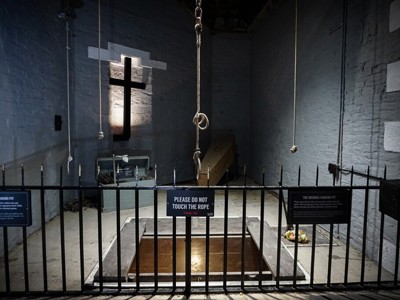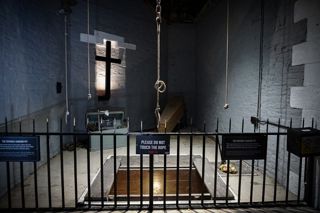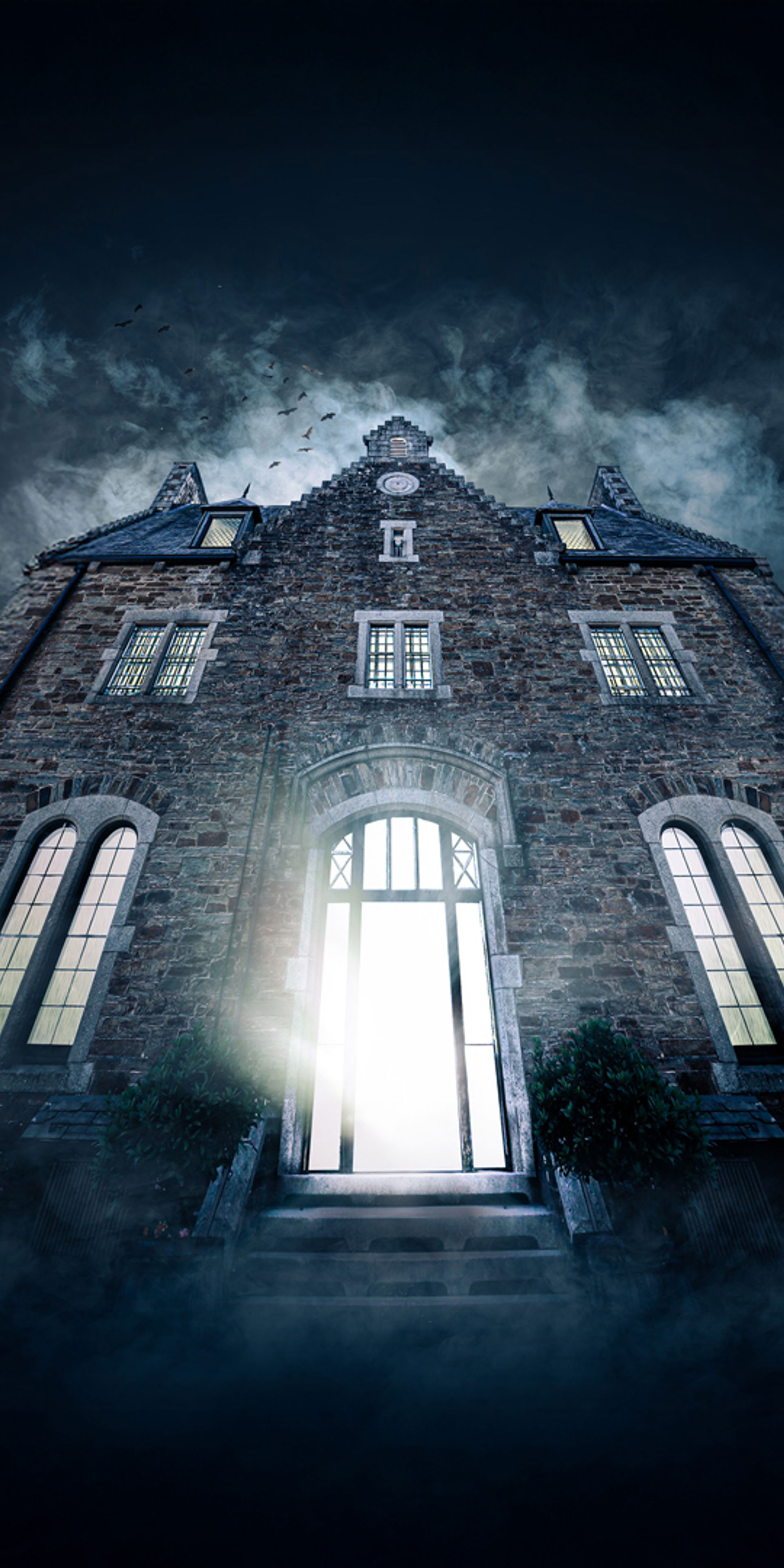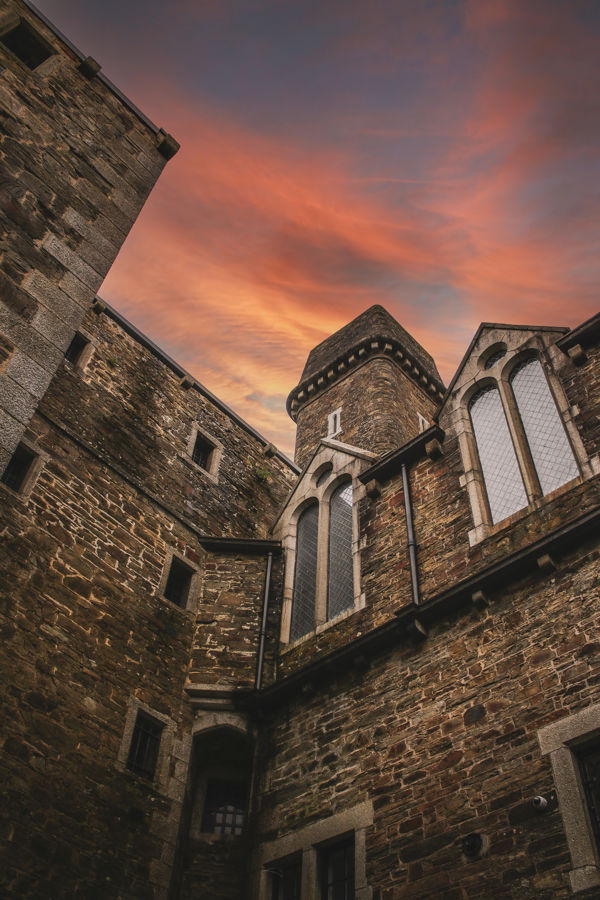
Executions

Early executions took place at Bodmin Common, just at the edge of the town. From 1802 to 1828, drop gallows were used in the field outside the front of the jail. The first confirmed hangings carried out were those of John Vanstone and William Lee, who were publicly hanged in front of the jail on Wednesday 1st September 1802.
Between 1834 and 1856, a new drop was used over the main gate known as the ‘standard drop’ or ‘short drop.’ This method of hanging was more of a torture than anything else – it did not break the vertebrae in the neck immediately, leaving the condemned to die a slow, often painful death by strangulation.
History dictates that the initial drop was declared illegal by the Inspector of Prisons due to the fact that the main gate pointed to the North East, and the hangings were not public enough. The drop was therefore moved to the south wall to allow for very large numbers of people to witness the executions from the nearby Asylum Hill.
When the Lightfoot Brothers were executed in 1840, it is estimated that a crowd of around 25,000 people gathered to watch the executions. This included passengers on nearby trains, which were halted below the prison wall to allow spectators to watch without leaving the wagons.
In 1868, a new law declared that executions needed to take place in private. All public executions therefore ceased.

William Marwood (1872-1883) was the pioneer of the ‘long drop’, which was a new, more humane way of hanging based on calculating the length of rope needed for an individual’s height, weight and muscular build. The prisoner’s neck was broken instantly at the end of the drop, resulting in death by asphyxia while unconscious.
Marwood, who preferred the term ‘executioner’ rather than hangman, went on to hang 176 prisoners in his career. He officiated at Bodmin Jail twice, and in both cases, death was instantaneous with each culprit receiving a drop of eight feet.
In 1886, a committee was set up on the orders of Queen Victoria to Lord Aberdare, resulting in the ‘Aberdare Report’ dictating changes in the way executions were carried out.
At Bodmin Jail, new gallows were constructed in 1897, built in accordance with the regulations set out by the Aberdare report. The new Execution Pit was housed in an Execution Shed; it's still there in the corner of the front yard of the jail today.
Bodmin Jail currently has the only working Execution Pit in the UK, and this forms part of the new attraction route. The original Victorian structure was rediscovered during renovation works in 2005 and was fully restored with the assistance of Gary Ewart, one of the UK’s leading authorities on hanging.
-
1802
-
John Vanstone & William Lee
John Vanstone and William Lee were the first confirmed hangings at Bodmin Jail. They were both executed for burglary on Wednesday 1st September 1802.
-
-
1813
-
Elizabeth Osborne
![]()
Elizabeth Osborne was hanged in front of a large crowd on the 6th September 1813 for setting fire to her former boss’ mow of corn.
-
-
1820
-
Sarah Polgrean
![]()
Sarah Polgrean was executed at Bodmin on Saturday 12th August 1820, convicted of causing the death of her husband Henry Polgrean by putting rat poison in his
food.
-
-
1828
-
Elizabeth Commins
Elizabeth Commins was hanged on Friday 8th August 1828 before a very large crowd, convicted of murdering her illegitimate child soon after birth. It is worth noting that a dissection of her body may possibly have been carried out in public as a warning to others!
-
-
1840
-
The Lightfoot Brothers
![]()
The Lightfoot Brothers were executed in front of a very large crowd of around 25,000 people on Monday 13th April 1840. They were convicted of murdering Nevill Norway, a merchant, in a highway robbery gone wrong.
-
-
1844
-
Matthew Weeks
![]()
Matthew Weeks was hanged on 12th August 1844 in front of a crowd of several thousand people outside Bodmin Jail. He was convicted of murdering his girlfriend Charlotte Dymond, whose murder is written into the folklore of Bodmin Moor.
-
-
1854
-
James Holman
James Holman was executed by William Calcraft on the 3rd April 1854 and buried in an unmarked grave near the Western cross wall of the jail. He was convicted of brutally murdering his wife, who was seven months pregnant at the time.
-
-
1862
-
John Dodge
![]()
John Doidge was hanged on 18th August 1862 for murdering Roger Drewe. This was the last public execution in Cornwall. The executioner was William Calcraft, who was at that time the Chief Executioner in Great Britain, and 6,000-8,000 people came to watch Doidge's demise.
-
-
1878
-
Selina Wadge
![]()
Selina Wadge was executed on 15th August 1878 for the murder of her youngest child. Her execution, which was the first at Bodmin in 16 years, was carried out by William Marwood using the ‘long drop’ method – her last words were noted as ‘Lord, deliver me from this miserable world’.
-
-
1882
-
William Bartlett
![]()
William Bartlett was also executed by William Marwood at Bodmin Jail on 13th November 1882 for the murder of his illegitimate two week old baby daughter. Reports say that whilst awaiting execution, Bartlett’s black hair turned completely white. Bartlett was the last person to be hanged from the side goods door of the prison, and his body was buried in quicklime within the stone yard.
-
-
1901
-
Valeri Giovanni
![]()
In 1901 an Italian sailor named Valeri Giovanni became the first person to be executed in the new hanging pit that had been constructed in 1897. He was convicted of the wilful murder of Mr Victor Bayliff, a seaman native to Jersey.
-
-
1909
-
William Hampton
![]()
William Hampton was executed on July 20th 1909 after being found guilty of murdering his girlfriend, Emily Tredrea by strangulation. Despite a 3,000 signature petition for mercy, at 08.00 he was given a ‘drop of seven feet as he was a man of slight build standing some 5 feet 8 inches and approx. 10 stone.’ This execution was the very last to take place at Bodmin Jail and in the County of Cornwall.
-

Sign up to our newsletter
Get the latest news and offers










